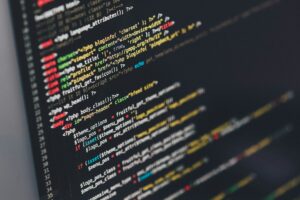As the language of choice for both beginners and industry professionals, Python stands out for its readability, efficiency, and extensive library ecosystem. In this guide, we aim to equip you with foundational knowledge and practical skills. Whether you're taking your first steps into coding or seeking to deepen your proficiency, these lessons are tailored to provide a comprehensive understanding of Python's capabilities, logic structures, program flow, and real-world applications. Join us on this journey as we unlock the power of Python and set the stage for your future developments.
The Basics of Python Syntax
Python's syntax is known for its simplicity and readability, which makes it an excellent starting point for those new to programming. It utilizes English-like commands and has very strict punctuation rules, which means indents and spacing are crucial for the structure of your code. Understanding the fundamentals of Python's syntax will help you write clear and readable code—a common best practice in the programming world.
To truly grasp Python syntax, it's important to familiarize yourself with basic concepts such as variables, data types, and operators. Practice writing simple statements and expressions to see how Python processes information. Experiment with string manipulation, mathematical calculations, and input-output operations to get comfortable with everyday coding tasks in Python. You can learn to code through various courses and resources online, but it's essential to put theory into practice by writing your code. It's through these hands-on experiences that you'll develop an intuitive understanding of Python's syntax.
Control Flow in Python
Control flow is about making decisions in your code. In Python, this is done through conditional statements, loops, and function calls. You'll learn how to use `if`, `elif`, and `else` statements to execute code based on different conditions. Mastering these will allow you to write programs that can solve complex problems by making decisions on the fly.
Loops, such as `for` and `while`, are another essential part of control flow. They allow you to perform a task repeatedly over a range, a list, or while a certain condition is true. Functions, on the other hand, enable you to encapsulate code blocks for reusability and better organization. These constructs work together to give you the ability to write efficient and powerful code that handles a wide variety of tasks in Python.
Lists, Tuples, and Dictionaries
In this lesson, we delve into Python's built-in data structures—namely lists, tuples, and dictionaries. Each serves a unique purpose and is useful in different scenarios. Lists are mutable and can be altered in place. They are ideal for collections of items that may need to change over the life of a program. Lists also support methods for the addition, removal, and sorting of elements.
Tuples are similar to lists but are immutable, meaning they cannot be changed once created. This property makes them perfect for storing a collection of items that should not change, such as the days of the week. Dictionaries, on the other hand, store data in key-value pairs and are highly optimized for retrieving data. They are ideal for instances where items are named or labeled, such as a contact book.
Functions and Modules
Functions are self-contained blocks of code that perform a specific task. In Python, defining a function with `def` opens up possibilities for code reusability and organization. By understanding how to create and use functions, you can write more modular code that's easier to test and maintain. The lesson will also cover the scope of variables within functions to avoid conflicts and unexpected behavior in your programs.
Modules are another level of abstraction in Python. They allow you to organize functions, variables, and classes into separate files. This makes your codebase more manageable and promotes the use of libraries—pre-written code that you can include in your projects. Learning to use modules and libraries effectively will significantly speed up your coding process and extend Python’s capabilities.
Exception Handling and File Operations
Real-world applications require robust exception handling to manage unexpected events without crashing. In Python, this is managed through `try`, `except`, and `finally` blocks. This lesson demonstrates how to anticipate and manage errors, such as handling file not-found errors or incorrect user input, ensuring your programs are reliable and user-friendly.
File operations are crucial for programs that need to save or read data. Python provides simple functions for file handling, such as `open`, `read`, `write`, and `close`. Understanding these will allow you to work with files for data storage, which is essential for tasks like data analysis, where reading from and writing to files is a common requirement.
Object-Oriented Programming (OOP) in Python
OOP is a paradigm that represents concepts as "objects" with attributes and methods. Python fully supports OOP, allowing for encapsulation, inheritance, and polymorphism. This lesson will introduce you to defining classes and creating objects, thus leveraging the power of OOP to create well-structured, reusable code.
By learning to implement classes, you will be able to create custom data types that can have their own behavior and logic. We will also explore inheritance, which allows for the creation of subclasses that can modify or extend the functionality of parent classes, and polymorphism, which enables objects to be treated as instances of their parent class, enhancing flexibility in how functions and methods can be used.
In conclusion, Python offers a range of features that make it an ideal language for both beginners and experts. By mastering its syntax, control flow, data structures, functions and modules, exception handling and file operations, as well as OOP principles, you will have the tools to tackle complex problems in a simple yet powerful manner.


